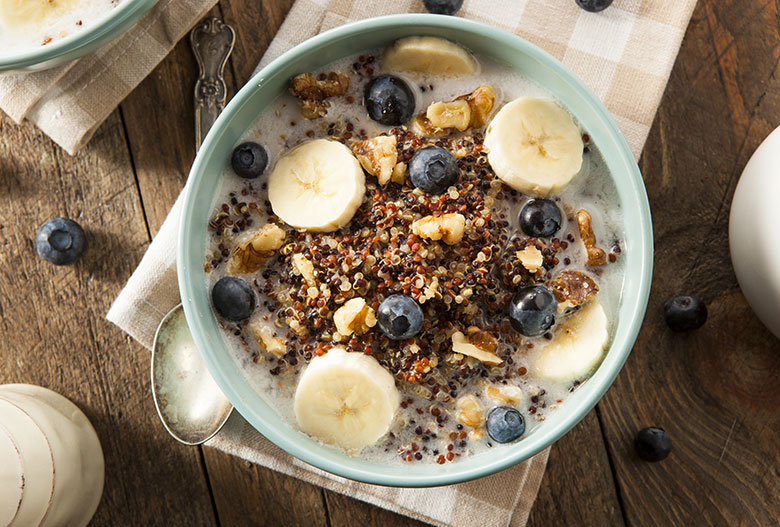- Fiber is a type of carbohydrate that the body can’t digest and unlike most other carbohydrates cannot be broken down into sugar molecules.
- Fiber is an important component of a healthy dietary pattern and helps curb hunger (improves satiety) and helps to keep blood sugar at normal levels. It is found in abundance in whole fruits and vegetables, whole grains, and beans.
- Most Americans unfortunately get less than half of their minimal amounts of fiber. Children and adults need at least 20 to 30 grams of fiber per day for good health.
Fiber is a type of carbohydrate (just like sugars and starches) and is included as part of the total carbohydrate amount on food labels. Despite the fact that fiber is non-digestible and has no caloric effect it does have important health benefits that make it indispensable for best health.
Different types of fiber
There are two kinds of fiber and both are beneficial: soluble fiber (dissolves in water) and the insoluble kind (does not dissolve in water). Soluble fiber is found in oatmeal, nuts, beans, lentils, apples and blueberries. Most sources of dietary fiber have both soluble and insoluble fiber in varying amounts, but whole grain products generally contain a high proportion of insoluble fiber. In the U.S. diet, the main sources of soluble fiber are fruits and vegetables, and to a smaller extent, oats and barley.
Fiber is important in healthy nutrition since it can help lower cholesterol and blood sugar and help in the prevention and management of insulin resistance -the condition related to prediabetes and type 2 diabetes.
Improved metabolism
It is thought that a major benefit of soluble fiber is related to the viscous and gel-forming properties of this type of dietary fiber that can improve the feeling of fullness and decrease hunger (improve satiety) by slowing stomach emptying.
Insoluble cereal dietary fiber and whole grains also have positive metabolic effects with improved blood sugar and decreased insulin resistance. An increase of high dietary fiber intake is emphasized for those with prediabetes and diabetes. Insoluble fiber, more than soluble fiber has the greater association with improvements in insulin resistance and a lower diabetes risk -based on recent studies. A review of nine cohort studies on fiber (meta-analysis) found a higher association for cereal fiber (whole grains) and decreased insulin resistance and diabetes risk, but not other fibers (Schulze et al., 2007).
Insulin resistance is a problem that can develop with increased weight -especially when it is around the waist. This condition often is associated with higher than normal blood insulin levels and is associated with prediabetes -the very common condition affecting half of adults over age 20. Since one in three Americans born in 2000 or later and some 50% of high-risk ethnic groups are expected to develop type 2 diabetes the finding of prediabetes can be considered the “canary in the cave.” The call to action is to limit added and hidden sugars, refined carbohydrates and increase dietary fiber from whole grains, lentils, fruits and vegetables is very important since this condition can be prevented. Another common insulin resistance disorder affecting 5-10% of women of childbearing age is called polycystic ovarian syndrome (PCOS). The key to successful treatment is also a nutritional pattern rich in more dietary fiber and less highly refined carbs. PCOS is associated with irregular menstrual cycles and decreased fertility.
Soluble fiber modestly lowers LDL-C -commonly called “bad” cholesterol. Expect about a 6mg/dL drop of LDL-C for every gram of fiber.
Given the important metabolic benefits of fiber it is not surprising to find scientific studies that validate the importance of more dietary fiber in the prevention of heart disease.
Lowered heart disease risk
Large prospective studies with long-term follow-up found that individuals consuming a nutrition pattern with increased dietary fiber from grains have shown a lower risk of heart disease including a lower risk of death from heart disease –the number one killer of Americans. The vast majority of studies suggest the risk of death from cardiovascular disease drops by about 19% per 10-gram increase in fiber per day.
A study involving about 40,000 male health professionals demonstrated a high total dietary fiber intake was linked to a 40 percent lower risk of coronary heart disease, compared to a low fiber intake. Cereal fiber, which is found in grains, seemed particularly helpful.
Colon health
Insoluble fiber is found in wheat, whole wheat bread, whole grain couscous, brown rice, legumes, carrots, cucumbers, spinach, kale, chard, book chop, soya beans and tomatoes can be helpful for those with gastrointestinal (GI) problems such as diverticular disease (diverticulosis) and chronic constipation. Diverticular disease is a very common age-related disorder of the colon with about one in three of us over age 45-years showing up with diverticulosis. The most commonly reported “GI” complaint the USA is constipation. Eating more dietary fiber, particularly insoluble fiber, was associated with about a 40 percent lower risk of diverticular disease in a large study of male health professionals studied by the Harvard School of Public Health. (Aldoori WH, et al. A prospective study of dietary fiber types and symptomatic diverticular disease in men. J Nutr. 1998;128:714-9).
Summary
Recommendations from the Dietary Guidelines is to increase fiber-rich fruits, vegetables, and whole-grains consumption (14 grams of fiber per 1000 calories) are based on both the highest level of clinical studies -randomized studies and multiple population studies that all show positive clinically important health benefits.
Munter JS, et al. Whole grain, bran, and germ intake and risk of type 2 diabetes: a prospective cohort study and systematic review. PLoS Med. 2007;4:e261
Hoeger, KM. Obesity and Lifestyle Management in Polycystic Ovary Syndrome. Clinical Obstetrics and Gynecology. 2007; 50: 277-294

